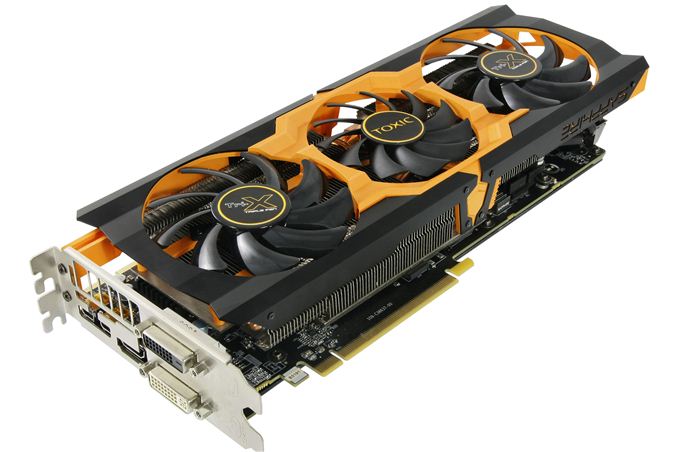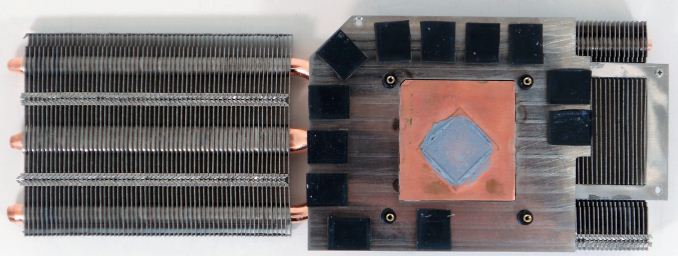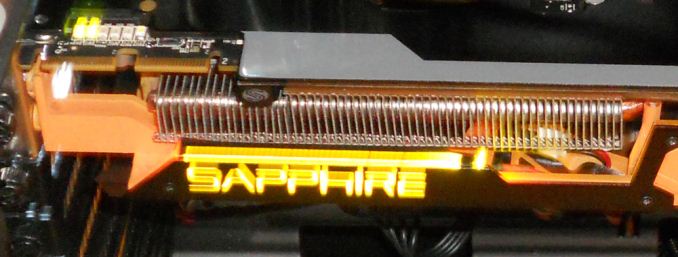The Sapphire R9 280X Toxic Review
by Ryan Smith on October 10, 2013 8:00 AM EST- Posted in
- GPUs
- Radeon
- Sapphire
- Tahiti
- Radeon 200

With AMD’s Radeon R9 280X being based on the company’s now venerable and battle-tested Tahiti GPU, AMD’s partners have wasted no time in releasing fully customized products for AMD’s new lineup. Whether it’s reusing a tried and true design from the 7970 and 7970 GHz Edtion, or coming out with a new design entirely, everyone is doing something to make their card unique. In fact you won’t even find a reference card for the 280X launch; everything is custom from day one.
Of course it’s not just boards and coolers that can be adjusted. With nearly 2 years knowledge on the performance characteristics and yield curves of the Tahiti GPU, partners aren’t wasting any time in releasing aggressively clocked designs in their first salvo. We’ve already seen Asus make their first move with their R9 280X DirectCU II TOP, and they won’t be alone. But of all the designs being released in the next week for the 280X, none that we’re aware of are quite as aggressive as what Sapphire will be going for with their 280X Toxic.
| AMD GPU Specification Comparison | ||||||
| Sapphire R9 280X Toxic | Asus Radeon R9 280X DCU II TOP | AMD Radeon HD R9 280X | AMD Radeon HD 7970 GHz Edition | |||
| Stream Processors | 2048 | 2048 | 2048 | 2048 | ||
| Texture Units | 128 | 128 | 128 | 128 | ||
| ROPs | 32 | 32 | 32 | 32 | ||
| Core Clock | 1100MHz | 970MHz | 850MHz | 1000MHz | ||
| Boost Clock | 1150MHz | 1070MHz | 1000MHz | 1050MHz | ||
| Memory Clock | 6.4GHz GDDR5 | 6.4GHz GDDR5 | 6GHz GDDR5 | 6GHz GDDR5 | ||
| VRAM | 3GB | 3GB | 3GB | 3GB | ||
| Typical Board Power | >250W | >250W | 250W | 250W | ||
| Width | Double Slot | Double Slot | Double Slot | Double Slot | ||
| Length | 12.25" | 11.25" | N/A | N/A | ||
| Warranty | 2 Years | 3 Years | N/A | N/A | ||
| MSRP | $349 | $309 | $299 | N/A | ||
Meet The Sapphire R9 280X Toxic
Clocked at 1100MHz for the base GPU clock and 1150MHz boost GPU clock, with the their 280X Toxic Sapphire is aiming to have the fastest 280X card on the market. This is 250MHz (29%!) faster than the stock 280X at base clockspeeds, and 150Mhz (15%) faster under full boost. This is a very high and very narrow range of clockspeeds that according to the various 280X card specs we have so far makes the 280X Toxic the highest clocked card on the market, and one that will always be performing very close to its peak clockspeeds thanks to that narrow boost range. To that end 1150MHz is by no means unheard of for a Tahiti overclock, but by our reckoning it is towards the tail end of what a good Tahiti GPU can do under a reasonable voltage and air cooling, so Sapphire dipping well into the tail end of the yield curve to bring this card together. In any case, complementing the GPU overclock is a smaller memory overclock of 400MHz (7%) to keep the GPU fed.
Meanwhile cooling Sapphire’s highly clocked beast is a new cooler design out of Sapphire that is not necessarily the largest of the dual-slot GPU coolers, but certainly among the longest at 12.25 inches. Dubbed the Tri-X cooler, Sapphire is using a 3 fan asymmetrical design that takes a pair of 90mm fans with an 80mm fan in the center to provide all of the airflow the card needs. In that respect this is fairly typical for a triple fan open air cooler, though making Sapphire one of only a couple of companies to use this design in any product in lieu of a dual fan design.
Located below and measuring just a bit shorter than the fan-shroud is the 280X Toxic’s heatsink, a two segment vertical fin design. Sapphire is using 5 copper heatpipes to move heat between the GPU and the heatsink, with two pipes going to the first segment located over the GPU while the other three go to the segment at the tail end of the card, with the largest of these heatpipes measuring 10mm in diameter and tying it for the largest heatpipes we’ve seen yet.
Pulling away the heatsink we can find a couple of other heatsinks and a baseplate to pick up the slack for what the primary heatsink can’t cover alone. A baseplate attached to the larger heatsink segment provides cooling for the Hynix RAM chips and other discrete components around the GPU, while another strip heatsink is attached to the MOSFETs that are part of the card’s voltage regulation equipment. This smaller heatsink isn’t attached to the primary heatsink in any way, so cooling comes off of the airflow from the fans.
On the back side of the card we’ll find a backplate that Sapphire has attached to the card and runs the full length of the PCB. There aren’t any components on the back of the card that the backplate provides direct cooling for, but it does provide another heat outlet for the MOSFETs on the front of the card, with a strip of thermal material connecting the backplate to the location on the PCB where the MOSFETs are. The backplate also provides some protection for the chokes Sapphire has placed on the back of the card, as the backplate sticks out farther than the chokes. Meanwhile for those who like to show off or otherwise have their video card visible, on the back we’ll also find Sapphire’s LED temperature LEDs, a series of 6 LEDs that will light up in accordance with the GPU temperature.















84 Comments
View All Comments
ShieTar - Monday, October 14, 2013 - link
Test results depend strongly on the case used for the testing and also on the geometry of the measurement room, most importantly the distance between the card and the microphone.I seem to remember that AT is testing with the card in an open setup, while kitguru are referring to a closed chasis in the review you have linked.
Ryan Smith - Monday, October 14, 2013 - link
For general testing we're in a closed setup, specifically a NZXT Phantom 630 (as listed in our test apparatus section).Also, keep in mind that our intention here is for these results to be relative, not absolute. We're primarily concerned with which card is louder/quieter and by how much. The problem with absolute results is that more so than any other attribute we test, it varies heavily with the environment, both with regards to the case and the room the computer is setup in.
FuriousPop - Thursday, October 10, 2013 - link
hhmmmmm.........not that impressive from the red team and im guessing the 290X will just be a supe'd up 280X (hopefully not). but i think i'll be sticking with my cfx 7970's (asus top versions)... but if the green team drop the 770/780's in price then i do believe those will be a price - performance wise bargin... i guess we must still wait for the 290X to come.....and see...Mombasa69 - Monday, October 14, 2013 - link
"hhmmmmm.........not that impressive from the red team" LMAO! It's near 30% faster than a standard 7970 and is full DX11.2... numb nuts. Even beats a 780 on half the benchmarks and the true Radeon optimized games designed for the new Radeon using consoles aren't even out yet.All this for only £260-£280!
jenesis33 - Thursday, October 10, 2013 - link
NV already stated they are not dropping price for GTX 770 / 780.So yeah. i understand this is not impressive for ppl arleady have 7970 and etc.
But for some1 like me who is upgrading from a GTX 560, i think it's great news.. Awesome performance for price...
FuriousPop - Thursday, October 10, 2013 - link
i disagree - for those in your position i would rather upgrade to a gtx670 or 7850 (or there abouts), save those extra bucks for early next year or better yet, stick with what you got now and purchase something early-mid next year. i only got my 7970's late last year, before that i had a 4870 for as long as i can remember (tried 2xgtx670's but 1 of them DOA, hence 7970 the only choice).prices will always drop - my thoughts have always been whats the best value not what is the best performer out there.... and with this 280X power hunger mode on, i don't see the 290X being any better in that department therefore requiring more out of your whole system to utilize the full performance of it, to which i don't think its worth it....but hey, go nuts if you like!
Yeoman1000 - Friday, October 11, 2013 - link
You can always wait, but you can never really win with tech. In the uk, 7850 is about £110-130. 7970 can be had for £210-230. Bear in mind the 3gb & 384-bit...for peeps in the uk at least it seems like 'old' 7970 stock is the same excellent value as a 7850, for now at least it seems you can't lose.commissar0617 - Saturday, October 12, 2013 - link
WHO CARES ABOUT POWER CONSUMPTION? a 200w power draw difference will mak minimal difference if your power bill....ShieTar - Monday, October 14, 2013 - link
For a serious gamer (1000 hours a year at least), with assumed electricity cost of 0.20$ / kWh, thats already 40$ a year. Keep in mind that people who need to watch that kind of money are often students, some of them playing (and/or working) more than 1000 hours a year, and also keep in mind that some of the international readers of AT may also pay 0.50$/kWh, and you may also be looking at 200$ or more cost per year. Most people won't call that minimal.That aside, I personally do not worry about 60$ electricity per year, but 200W additional draw will lead to a noticeable increase in noise, and that I do care about a lot. So I most definitely care to see those numbers in any review.
Mombasa69 - Monday, October 14, 2013 - link
I'll be upgrading my 3 way 570's for 2 of these Sapphire Radeon R9 280X Toxic's, it even comes with a great oc utility, a small tweak and it'll be as good as the over-priced 780.